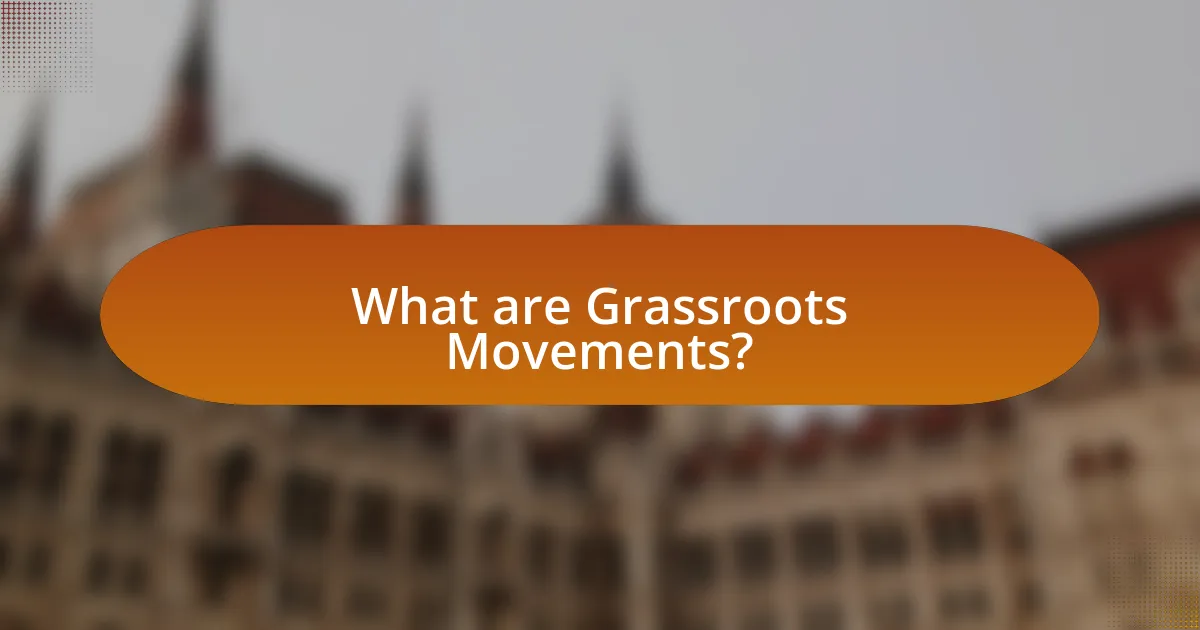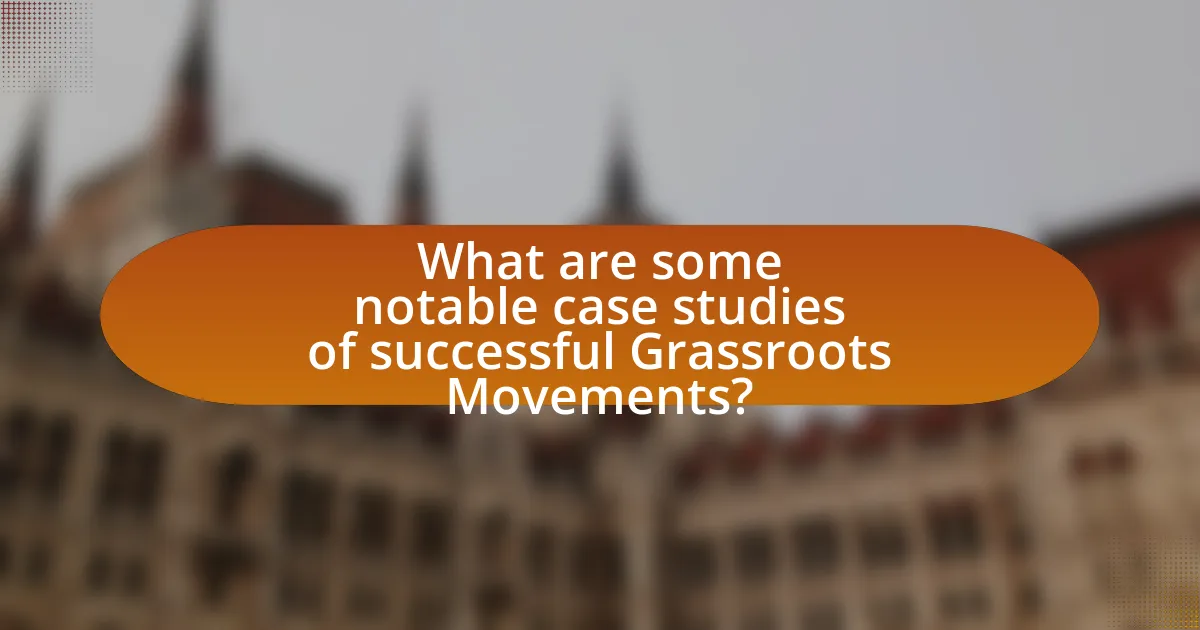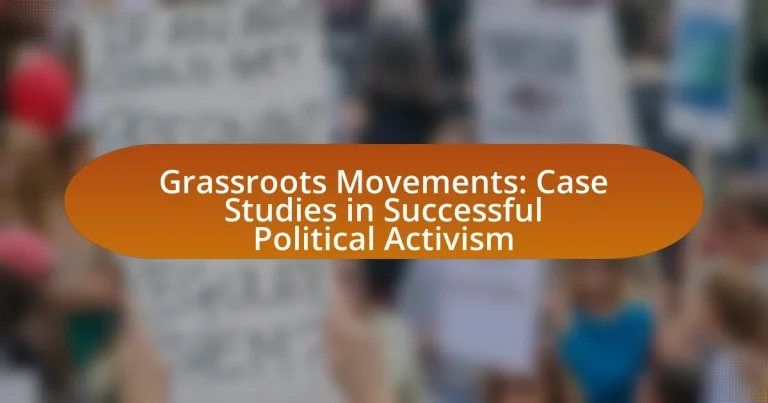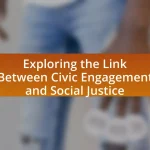Grassroots movements are collective efforts initiated by ordinary individuals at the community level aimed at achieving social or political change. This article explores the defining characteristics of grassroots movements, their differences from traditional political activism, and their significance in modern politics. It highlights notable case studies, such as the Civil Rights Movement and the Women’s March, illustrating how local leadership and community engagement drive these movements. Additionally, the article addresses the challenges grassroots movements face today, including funding limitations and political opposition, while offering strategies for effective mobilization and collaboration with established organizations.

What are Grassroots Movements?
Grassroots movements are collective efforts initiated by ordinary people at the community level to effect social or political change. These movements often arise in response to specific issues, such as environmental concerns, social justice, or political representation, and rely on the active participation and mobilization of community members rather than top-down leadership. Historical examples include the Civil Rights Movement in the United States, which was driven by grassroots activism to combat racial segregation and discrimination, demonstrating the power of local organizing in achieving significant legislative changes.
How do Grassroots Movements differ from traditional political activism?
Grassroots movements differ from traditional political activism primarily in their structure and approach to mobilization. Grassroots movements are typically community-driven, relying on local participation and collective action from individuals at the base level, whereas traditional political activism often involves established organizations, political parties, or leaders directing efforts from the top down. For example, the Civil Rights Movement in the United States was largely grassroots, with local communities organizing protests and sit-ins, while traditional political activism might involve lobbying by established interest groups or political campaigns led by candidates. This distinction highlights how grassroots movements prioritize direct engagement and empowerment of individuals, contrasting with the hierarchical nature of traditional activism.
What are the defining characteristics of Grassroots Movements?
Grassroots movements are characterized by their community-driven nature, where ordinary individuals mobilize to advocate for social or political change. These movements typically emerge from local concerns and rely on collective action, emphasizing participation and engagement from the grassroots level rather than top-down leadership. They often utilize informal networks and social media to organize and spread their message, allowing for rapid mobilization and outreach. Historical examples, such as the Civil Rights Movement in the United States, illustrate how grassroots efforts can lead to significant societal change, demonstrating the power of community involvement in activism.
Why are Grassroots Movements important in modern politics?
Grassroots movements are important in modern politics because they empower ordinary citizens to influence policy and drive social change. These movements often arise from community-level concerns, allowing individuals to collectively address issues that affect their lives, such as environmental justice, healthcare reform, and civil rights. For instance, the Black Lives Matter movement has mobilized millions to advocate for racial equality and police reform, demonstrating the power of grassroots activism in shaping national discourse and policy. Additionally, grassroots movements can challenge established political structures, as seen in the Tea Party’s impact on the Republican Party, which shifted its platform towards more conservative policies. This illustrates how grassroots initiatives can reshape political landscapes and engage citizens in the democratic process.
What role do community engagement and local leadership play in Grassroots Movements?
Community engagement and local leadership are crucial in grassroots movements as they foster participation, build trust, and mobilize resources. Engaged communities are more likely to identify shared goals and collaborate effectively, which enhances the movement’s legitimacy and impact. Local leaders serve as facilitators, guiding efforts and ensuring that the voices of community members are heard. For instance, the Civil Rights Movement in the United States saw local leaders like Martin Luther King Jr. and grassroots organizations mobilizing community support, which was essential for achieving significant legislative changes, such as the Civil Rights Act of 1964. This historical example illustrates how community engagement and local leadership can drive grassroots movements toward successful political activism.
How does local leadership influence the success of Grassroots Movements?
Local leadership significantly influences the success of grassroots movements by providing direction, mobilizing community support, and fostering trust among participants. Effective local leaders possess an understanding of community needs and can articulate a vision that resonates with residents, which is crucial for rallying support. For instance, the Civil Rights Movement in the United States saw local leaders like Martin Luther King Jr. and Rosa Parks effectively mobilizing grassroots efforts, leading to significant legislative changes such as the Civil Rights Act of 1964. Their ability to connect with the community and inspire collective action was instrumental in achieving these successes. Additionally, local leaders often serve as a bridge between grassroots movements and larger political structures, facilitating access to resources and networks that can amplify the movement’s impact.
What strategies are effective for community engagement in Grassroots Movements?
Effective strategies for community engagement in grassroots movements include building strong relationships, utilizing social media, and organizing local events. Building strong relationships fosters trust and encourages participation, as seen in the success of movements like Black Lives Matter, which emphasizes community connections. Utilizing social media platforms allows for rapid dissemination of information and mobilization of supporters, demonstrated by the Arab Spring, where social media played a crucial role in organizing protests. Organizing local events, such as town halls or community forums, creates spaces for dialogue and collaboration, as evidenced by the success of the Women’s March, which engaged diverse communities through inclusive gatherings. These strategies collectively enhance community involvement and drive grassroots activism.

What are some notable case studies of successful Grassroots Movements?
Notable case studies of successful grassroots movements include the Civil Rights Movement in the United States, which effectively mobilized citizens to challenge racial segregation and discrimination, leading to significant legislative changes such as the Civil Rights Act of 1964. Another example is the anti-apartheid movement in South Africa, where grassroots activism played a crucial role in dismantling apartheid, culminating in the election of Nelson Mandela in 1994. Additionally, the Women’s Suffrage Movement in the early 20th century successfully advocated for women’s right to vote, resulting in the passage of the 19th Amendment in the U.S. in 1920. Each of these movements demonstrates the power of collective action and community organizing in achieving social and political change.
How did the Civil Rights Movement exemplify Grassroots Activism?
The Civil Rights Movement exemplified grassroots activism through its reliance on local communities to mobilize, organize, and advocate for social change. Activists, often ordinary citizens, formed organizations like the Student Nonviolent Coordinating Committee (SNCC) and the Southern Christian Leadership Conference (SCLC), which focused on community engagement and direct action. These groups organized sit-ins, marches, and voter registration drives, demonstrating the power of collective action at the local level. For instance, the 1963 Birmingham Campaign involved local residents who coordinated protests against segregation, leading to national attention and legislative change. This grassroots approach was pivotal in achieving milestones such as the Civil Rights Act of 1964 and the Voting Rights Act of 1965, showcasing how community-driven efforts can effect significant political and social transformation.
What strategies were employed by leaders in the Civil Rights Movement?
Leaders in the Civil Rights Movement employed strategies such as nonviolent protest, legal challenges, and grassroots organizing. Nonviolent protest, exemplified by events like the Montgomery Bus Boycott and the March on Washington, aimed to draw attention to racial injustices without resorting to violence. Legal challenges, notably through organizations like the NAACP, sought to dismantle segregation laws, culminating in landmark cases such as Brown v. Board of Education in 1954, which declared racial segregation in public schools unconstitutional. Grassroots organizing involved mobilizing local communities to participate in demonstrations and voter registration drives, significantly increasing African American voter turnout and political representation. These strategies collectively contributed to the advancement of civil rights and the eventual passage of key legislation, such as the Civil Rights Act of 1964 and the Voting Rights Act of 1965.
What were the key outcomes of the Civil Rights Movement?
The key outcomes of the Civil Rights Movement include the dismantling of legal segregation, the establishment of voting rights for African Americans, and the promotion of social justice and equality. The Civil Rights Act of 1964 prohibited discrimination based on race, color, religion, sex, or national origin, effectively ending segregation in public places and employment. Additionally, the Voting Rights Act of 1965 aimed to eliminate barriers to voting for African Americans, resulting in a significant increase in voter registration and participation. These legislative achievements were supported by grassroots activism, including protests, sit-ins, and legal challenges, which highlighted the demand for civil rights and equality in the United States.
What lessons can be learned from the Women’s March?
The Women’s March teaches the importance of collective action and solidarity in advocating for social change. This event, which took place on January 21, 2017, mobilized millions globally, demonstrating that grassroots movements can effectively raise awareness about issues such as women’s rights, racial equality, and LGBTQ+ rights. The sheer scale of participation, with estimates of over 4 million attendees in the United States alone, underscores the power of unity in amplifying voices and demands for justice. Additionally, the Women’s March highlighted the significance of intersectionality, as it brought together diverse groups to address overlapping social injustices, thereby fostering a more inclusive movement.
How did the Women’s March mobilize participants across diverse demographics?
The Women’s March mobilized participants across diverse demographics by leveraging a broad coalition of organizations and grassroots networks that emphasized inclusivity and intersectionality. This approach attracted individuals from various racial, ethnic, and socioeconomic backgrounds, as well as different age groups and gender identities. For instance, the March on January 21, 2017, drew an estimated 4.6 million participants in the United States alone, making it one of the largest single-day protests in U.S. history, with significant representation from women of color and LGBTQ+ communities. The organizers utilized social media platforms to disseminate information and foster community engagement, which facilitated outreach to underrepresented groups. Additionally, the March’s focus on issues such as reproductive rights, racial justice, and immigrant rights resonated with a wide audience, further enhancing its demographic diversity.
What impact did the Women’s March have on subsequent political activism?
The Women’s March significantly galvanized subsequent political activism by mobilizing millions of participants and inspiring a wave of grassroots movements. This event, which took place on January 21, 2017, saw an estimated 3 to 5 million people across the United States and around the world advocating for women’s rights and social justice issues. The visibility and scale of the Women’s March led to increased political engagement, as evidenced by a surge in voter registration and participation in local elections, particularly among women and younger voters. Additionally, the march served as a catalyst for the formation of various advocacy groups, such as Indivisible and the Women’s March Foundation, which focused on issues like reproductive rights, racial justice, and climate change. The impact of the Women’s March is further reflected in the 2018 midterm elections, where a record number of women were elected to Congress, demonstrating a direct correlation between the march and increased political representation.

What challenges do Grassroots Movements face today?
Grassroots movements today face significant challenges, including funding limitations, political opposition, and the impact of social media dynamics. Funding limitations hinder their ability to sustain operations and outreach, as many rely on small donations and volunteer efforts. Political opposition often manifests through legal barriers, regulatory challenges, or pushback from established political entities that feel threatened by grassroots initiatives. Additionally, social media dynamics can create misinformation and fragmentation within movements, making it difficult to maintain a unified message and mobilize supporters effectively. These challenges collectively impede the effectiveness and longevity of grassroots movements in achieving their goals.
How do funding and resource limitations affect Grassroots Movements?
Funding and resource limitations significantly hinder grassroots movements by restricting their ability to mobilize, organize, and sustain campaigns. Without adequate financial support, these movements struggle to cover essential costs such as outreach, materials, and event logistics, which are crucial for raising awareness and engaging the community. For instance, a study by the National Committee for Responsive Philanthropy found that grassroots organizations often receive less than 10% of total philanthropic funding, limiting their capacity to compete with larger, well-funded entities. This financial disparity can lead to reduced visibility and impact, ultimately stifling the movement’s effectiveness in advocating for change.
What are potential solutions to overcome funding challenges?
Potential solutions to overcome funding challenges include diversifying funding sources, leveraging community support, and utilizing crowdfunding platforms. Diversifying funding sources allows grassroots movements to reduce reliance on a single donor or funding stream, thereby increasing financial stability. For instance, organizations can seek grants from multiple foundations, engage in partnerships with local businesses, and explore government funding opportunities. Leveraging community support involves mobilizing local volunteers and advocates who can contribute time and resources, enhancing the movement’s capacity without significant financial outlay. Crowdfunding platforms, such as GoFundMe or Kickstarter, enable grassroots movements to reach a wider audience and raise small amounts of money from many individuals, which can accumulate to substantial funding. These strategies have been successfully employed by various grassroots movements, demonstrating their effectiveness in addressing funding challenges.
How can Grassroots Movements leverage social media for support?
Grassroots movements can leverage social media for support by utilizing platforms to mobilize communities, share information, and amplify their messages. Social media enables these movements to reach a wider audience quickly, facilitating real-time communication and engagement. For instance, the Black Lives Matter movement effectively used Twitter and Facebook to organize protests and spread awareness about racial injustice, resulting in significant public support and media coverage. Additionally, studies show that social media campaigns can increase participation rates in grassroots initiatives, as seen in the 2017 Women’s March, which garnered millions of participants globally through coordinated online efforts.
What strategies can enhance the effectiveness of Grassroots Movements?
Effective grassroots movements can be enhanced through strategic community engagement, coalition building, and leveraging social media. Community engagement fosters trust and mobilizes local support, as seen in the Civil Rights Movement, where grassroots organizations effectively organized local communities to advocate for change. Coalition building expands influence by uniting diverse groups with shared goals, exemplified by the Women’s March, which brought together various organizations to amplify their message. Leveraging social media allows for rapid dissemination of information and mobilization of supporters, demonstrated by the #MeToo movement, which utilized platforms to raise awareness and encourage participation on a global scale. These strategies collectively strengthen grassroots movements by increasing visibility, fostering collaboration, and enhancing community involvement.
How can collaboration with established organizations benefit Grassroots Movements?
Collaboration with established organizations can significantly enhance grassroots movements by providing access to resources, networks, and expertise. Established organizations often have funding, logistical support, and a broader audience, which can amplify the grassroots movement’s message and reach. For instance, partnerships with larger NGOs can lead to increased visibility and legitimacy, as seen in the collaboration between the grassroots organization Black Lives Matter and established civil rights groups, which helped elevate their cause on national platforms. This synergy not only strengthens advocacy efforts but also fosters a more sustainable impact by leveraging the strengths of both entities.
What role does grassroots lobbying play in influencing policy change?
Grassroots lobbying plays a crucial role in influencing policy change by mobilizing ordinary citizens to advocate for specific issues, thereby amplifying their collective voice. This form of lobbying often involves organizing campaigns, rallies, and petitions that demonstrate public support for particular policies, which can pressure lawmakers to take action. For instance, the 2018 March for Our Lives movement, initiated by students advocating for gun control, successfully influenced legislative discussions and led to the introduction of new gun safety measures in several states. Such grassroots efforts can effectively sway public opinion and create a sense of urgency around policy issues, making them a powerful tool for enacting change.
What are best practices for initiating a successful Grassroots Movement?
To initiate a successful grassroots movement, it is essential to build a strong community foundation by engaging local stakeholders and fostering relationships. This involves identifying key issues that resonate with the community, mobilizing supporters through effective communication strategies, and utilizing social media platforms to amplify the message. Historical examples, such as the Civil Rights Movement, demonstrate that grassroots efforts can lead to significant social change when there is a clear vision, organized leadership, and persistent advocacy. Additionally, research indicates that grassroots movements that prioritize inclusivity and diverse participation tend to achieve greater impact and sustainability.


